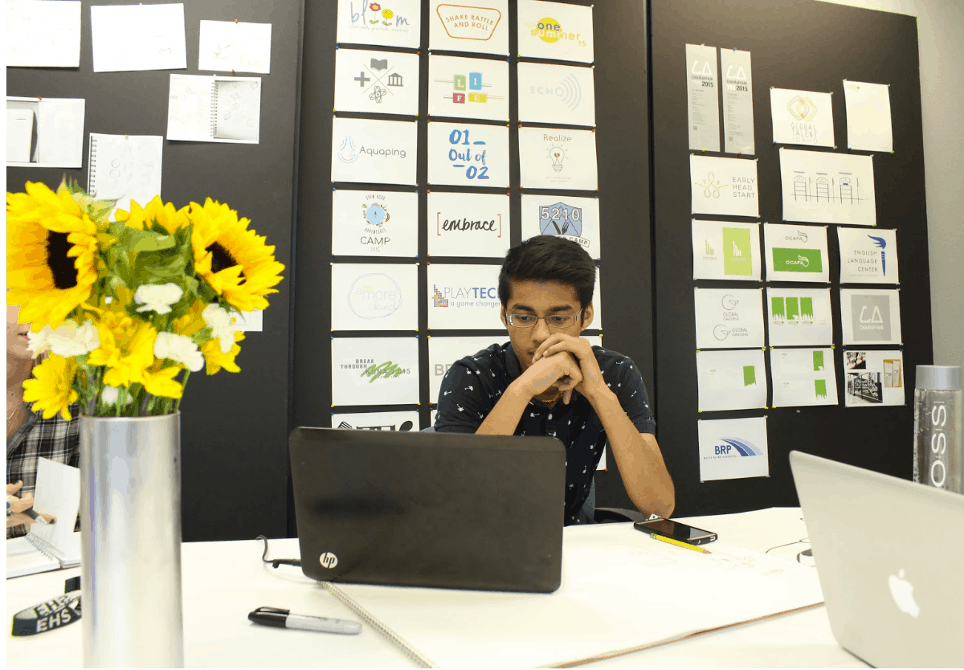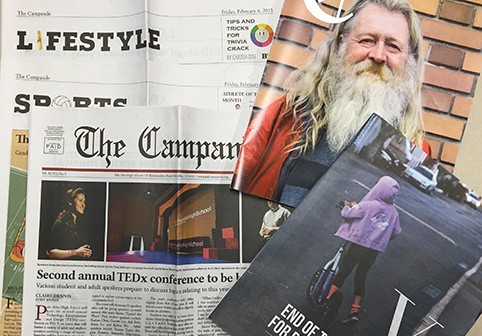Professional Grade: Magic Happens When Students Own High Standards

I asked Cole, one of the student leaders, how they help incoming high school juniors internalize high expectations. He said very crisply, “It’s three factors. Feedback from peer leaders, coaches and, most importantly, from clients.”
One Stone, founded by Teresa and Joel Poppen, provides developmental opportunities for about 200 Treasure Valley teens. A majority of the board are teens. One of three programs, Two Birds, provides design services to local business. Michael Reagan, an experienced designer and team leader, directs the program and is aided by four volunteer coaches from local marketing agencies.

Seniors who have been through several client engagements have heard One Stone design thinking principles including “you need to 51 it.” That means it may take 50 attempts or more to produce something that is good enough to put in front of a client (see One Stone design thinking process above).
In their second year in the program, seniors have received tough feedback from coaches telling them to go back to the drawing board. And after “51ing” a design and incorporating coach feedback, they may still have a client reject what seemed to be a great idea. Cole said that the first time he received client feedback it was brutal, but it created an indelible view of what quality looked like.
The result of high expectations and strong supports is spectacular work product, as you can see behind Parth Kashikar (featured image above) in the Two Birds space. Parth just completed two years in the Two Birds program that included an internship this summer.

“The beauty of Two Birds is that high school students get the opportunity to learn the strategy, creative process and technology behind website design and development, video production and branding in a safe, yet realistic agency environment,” said Reagan. He challenges everyone at Two Birds to ‘work like a boss,’ which “creates a culture of initiative, risk-taking, candor, competition, collaboration and ownership.”
The combination of peer feedback, coach feedback and client feedback creates in the youth leaders professional grade expectations—and that’s when magic happens.
Paly Journalism
The Palo Alto High School journalism program is another great example of student leaders owning high expectations and incorporating them into professional grade products.
Students at Paly lead ten professional quality publications including a newspaper, public affairs journal, arts and culture journal and yearbook (examples left).
Decades of professional quality publications set a high bar for new student editors.
Esther Wojcicki, who has been a media arts teach at Paly for 32 years, said, “We are preparing kids for a world we cannot even conceptualize.” She added, “They need to think, not follow directions. We need to move forward, take a risk; we have the tools and the skills to change the classroom and make learning exciting and relevant for all students.”
In Wojcicki’s book, Moonshots in Education, she encourages teachers to shoot for the moon.
“Moonshots involve goals that are difficult to achieve, perhaps seemingly impossible.”
The Flywheel of High Expectations
Some school administrators expect each teacher to set high expectations for their 150 students. A rubric and a few anchor papers and some tough early grading may be used to set the tone.
Schools like High Tech High make student work public by requiring frequent presentations of learning. They publish projects and student-authored books. Public audiences–in person and online–maintain high expectations for quality work across the High Tech network.
Students at Harmony Public School, a network of 46 Texas schools complete rigorous projects each year with the support of their teachers. Harmony students present their projects annually at the Texas STEM conference. Harmony students also present at public STEM expos, events, and conferences. Their work is published at STEM Students on the Stage. (See recent feature.)
As discussed in a new paper on project-based learning, public work product is one of the eight
Buck Institute Gold Standard PBL Essential Project Design Elements. Buck recommends that “Students make their project work public by explaining, displaying and/ or presenting it to people beyond the classroom.”
Ptech high schools combine project-based learning and work experiences to create high relevance. Corporate partners of the Ptech networks in New York and Idaho maintain high expectations.
The academic program at NYC iSchool focuses on challenge-based learning modules which connect students with client companies. Authenticity–real world context, tasks and tools–is also part of Buck’s Gold Standard.
These schools and programs suggest that high expectations are not just a product of individual teacher practice, but part of a school model, culture and community. Three practices appear to be critical to spinning the flywheel of high expectations:
- Outside in. A school culture that brings the outside in and where open feedback is valued. Jim Collins calls it a leadership paradox that starts with embracing brutal facts while maintaining the faith to prevail.
- Real work for real clients. Authentic challenging work combined with expectations of value creation are an invaluable learning experience.
- Public work. Requiring regular public presentations of work creates a global audience, and can lay the groundwork for a legacy of quality.
It’s easy to do projects, it’s hard to do them well. When you spin the flywheel of student ownership, it creates a sustainable culture of high expectations and quality–and that’s when magic happens.
For more see
- Wojcicki’s Classroom and Book Encourage Shooting for the Moon
- One Stone Launching Innovative New High School in Boise
- Preparing Students for a Project-Based World
Stay in-the-know with all things EdTech and innovations in learning by signing up to receive the weekly Smart Update. This post includes mentions of a Getting Smart partner. For a full list of partners, affiliate organizations and all other disclosures please see our Partner page.







https://twitter.com/pressurewashe14
I like this site very much so much wonderful information.